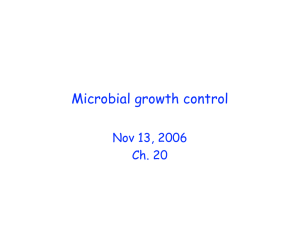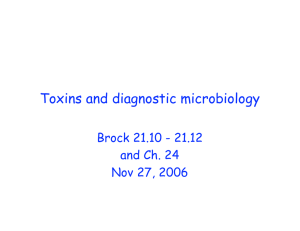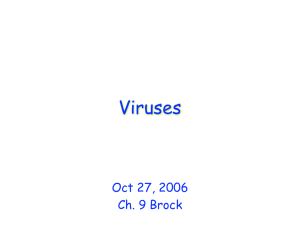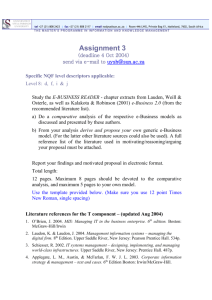Binary fission • In prokaryotes, growth = increase in number of cells
advertisement
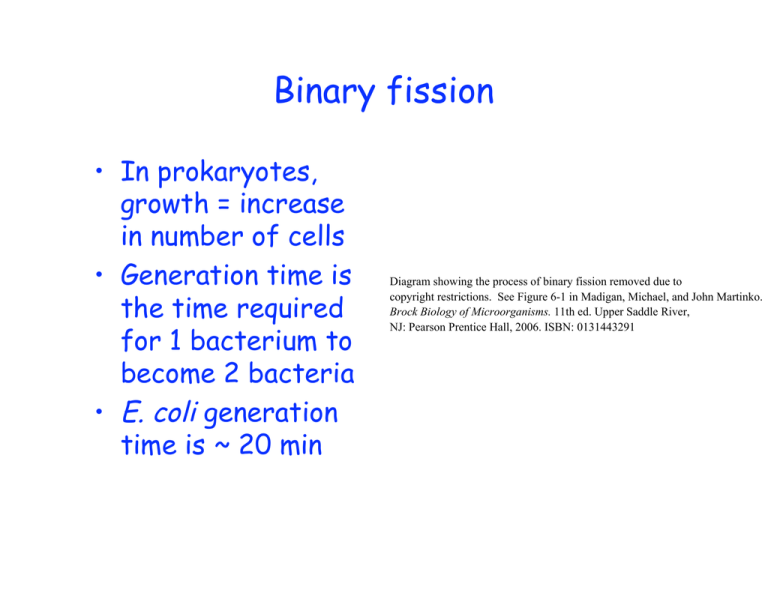
Binary fission • In prokaryotes, growth = increase in number of cells • Generation time is the time required for 1 bacterium to become 2 bacteria • E. coli generation time is ~ 20 min Diagram showing the process of binary fission removed due to copyright restrictions. See Figure 6-1 in Madigan, Michael, and John Martinko. Brock Biology of Microorganisms. 11th ed. Upper Saddle River, NJ: Pearson Prentice Hall, 2006. ISBN: 0131443291 Fts proteins and the “divisome” Image removed due to copyright restrictions. See Figure 6-2b in Madigan, Michael, and John Martinko. Brock Biology of Microorganisms. 11th ed. Upper Saddle River, NJ: Pearson Prentice Hall, 2006. ISBN: 0131443291. Peptidoglycan synthesis • New cell wall is synthesized from the FtsZ ring • Need to extend existing chains without compromising integrity • Autolysins without autolysis Images removed due to copyright restriction See Figure 6-3 in Madigan, Michael, and John Martinko. Brock Biology of Microorganisms. 11th ed. Upper Saddle River, NJ: Pearson Prentice Hall, 2006. ISBN: 0131443291. Peptidoglycan G M G G M M G G M M G G M M G G M M G Cytopasmic membrane G M M G G M G Growing point of cell wall Outside P P Inside Pentapeptide M P G P Bactoprenol Figure by MIT OCW. Exponential growth • From semi-log plot of cell density s a function of time can determine generation time (g) from time (t) and number of generations (n) • g = t/n Graph of cell growth over time removed due to copyright restrictions. See Figure 6-6b in Madigan, Michael, and John Martinko. Brock Biology of Microorganisms. 11th ed. Upper Saddle River, NJ: PearsonPrentice Hall, 2006. ISBN: 0131443291. Growth parameters • Number of cells (N) after n generations beginning with N0 cells • N = 2n N0 log N = n log2 + log N0 n = log N - log N0 0.301 Graph of cell growth over time removed due to copyright restrictions. See Figure 6-7b in Madigan, Michael, and John Martinko. Brock Biology of Microorganisms.11th ed. Upper Saddle River, NJ: Pearson Prentice Hall, 2006. ISBN: 0131443291. Related growth parameters • Slope = 0.301 n/t = the specific growth rate (k) • Division rate (v) = 1/g • Slope = v/3.3 • If you know n and t, you can calculate g, k, and v for organisms growing under different conditions The growth cycle • Lag phase • Exponential phase • Stationary phase Graph showing the lag, exponential, stationary, and death phases of cell growth removed due to copyright restrictions. See Figure 6-8 in Madigan, Michael, and John Martinko. Brock Biology of Microorganisms. 11th ed. Upper Saddle River, NJ: Pearson Prentice Hall, 2006. ISBN: 0131443291. Total cell count Diagram showing the process of a cell count removed due to copyright restrictions. See Figure 6-9 part 1 in Madigan, Michael, and John Martinko. Brock Biology ofMicroorganisms. 11th ed. Upper Saddle River, NJ: Pearson Prentice Hall, 2006. ISBN: 0131443291. 1. Does not distinguish live from dead 2. Can be hard to see small/moving cells 3. Not very precise 4. Need phase contrast microscope to count unstained cells 5. Need to concentrate dilute samples Viable count • Prepare 10-fold serial dilutions Diagram showing the process of a viable count removed due to copyright restrictions. • Plate sample of See Figure 6-11 in Madigan, Michael, and John Martinko. Brock Biology of Microorganisms. 11th ed. Upper Saddle River, NJ: Pearson Prentice Hall, 2006. each dilution ISBN: 0131443291. • Yields colonyforming units (CFU) • Can be discrepancy between viability and ability to form colonies Plating methods Diagram showing plating methods removed due to copyright restrictions. See Figure 6-10 in Madigan, Michael, and John Martinko. Brock Biology of Microorganisms. 11th ed. Upper Saddle River, NJ: Pearson Prentice Hall, 2006. ISBN: 0131443291. Turbidity as an indirect measure • Light scattering is proportional to the density of cells • Can create a standard curve from optical density Diagram showing the process of measuring turbidity removed due to copyright restrictions See Figure 6-12a in Madigan, Michael, and John Martinko. Brock Biology of Microorganisms. 11th ed. Upper Saddle River, NJ: Pearson Prentice Hall, 2006. ISBN: 0131443291. OD measurement of growth Bacterial Growth, Semi-Log 3.000 Absorbancy 660 nm 2.000 1.000 0.900 0.800 0.700 0.600 0.500 0.400 0.300 Photograph of a test tube of cells undergoing an OD measurement of growth removed due to copyright restrictions. 0.200 0.100 0.090 0.080 0.070 0.060 0.050 CSHA Minimal al Tryptone Soy Broth 0.040 0.030 0.020 0.010 0 30 60 90 120 150 180 210 240 Minutes Incubation, 37 C 270 300 Figure by MIT OCW. biology.clc.uc.edu/fankhauser/Labs/Microbiology Chemostat culture • Continuous culture device • Open system • At steady state, volume, cell number, and rate of growth are constant • Dilution rate – Growth rate • Limiting nutrient – Yield or density Image of a chemostat culture removed due to copyright restrictions. See Figure 6-13 in Madigan, Michael, and John Martinko. Brock Biology of Microorganisms. 11th ed. Upper Saddle River, NJ: Pearson Prentice Hall, 2006. ISBN: 0131443291. Batch culture Only Yield Affected Growth Yield ( Growth Rate ( ) ) Rate &Yield Affected 0 0.1 0.2 0.3 0.4 0.5 Nutrient Concentration (mg/ml) Figure by MIT OCW. Chemostat Steady-state Bacterial Concentration (g/l) A 4 6 3 4 2 1 0 2 B 0 0.25 0.5 Dilution Rate 0.75 1.0 Doubling Time (h) Steady state 5 0 Washout A = Bacterial concentration B = Doubling time Figure by MIT OCW. Cardinal temperatures • For any given organism there is a: • Minimum temp. • Optimum temp. • Maximum temp. • Microbes can grow wherever there is liquid water Graph showing cell growth vs. temperature removeddue to copyright restrictions. See Figure 6-16 inMadigan, Michael, and John Martinko. Brock Biology of Microorganisms. 11th ed. Upper SaddleRiver, NJ: Pearson Prentice Hall, 2006. ISBN: 0131443291. Classes of organisms Graph showing the optimal growth temperatures for a variety of organisms removed due to copyright restrictions See Figure 6-17 in Madigan, Michael, and John Martinko. Brock Biology of Microorganisms. 11th ed. Upper Saddl River, NJ: Pearson Prentice Hall, 2006. ISBN: 0131443291. Psychrophiles • Optimal ≤ 15°C, maximal ≤ 20°C, minimal ≤ 0°C Images of Psychrophiles removed due to copyright restrictions See Figure 6-19 in Madigan, Michael, and John Martinko. Brock Biology of Microorganisms. 11th ed. Upper Saddle River, NJ: Pearson Prentice Hall, 2006. ISBN: 0131443291. • Psychrotolerant organisms grow at 0°C but have optima between 20 and 40°C Hyperthermophiles • Optimum ≥ 80°C • Hot springs, deep sea vents • Most are archea • Protein changes • DNA stability • Membrane stability Images of hyperthermophiles removed due to copyright restrictions See Figure 6-20 in Madigan, Michael, and John Martinko. Brock Biology of Microorganisms. 11th ed. Upper Saddle River, NJ: Pearson Prentice Hall, 2006. ISBN: 0131443291. Thermophiles • Optimum ≥ 45°C • Both archea and bacteria • Important source of enzymes for biotechnology Image of thermophiles removed due to copyright restrictions See Figure 6-21 in Madigan, Michael, and John Martinko. BrockBiology of Microorganisms. 11th ed. Upper Saddle River, NJ: Pearson Prentice Hall, 2006. ISBN: 0131443291. pH and osmolarity • Acidophiles • Alkaliphiles • Halophiles – Mild 1-6% – Moderate 7-15% – Extreme 15-30% • Accumulate inorganic ions or make organic solutes http://en.wikipedia.org/wiki/Salt_evaporation_pond Compatible solutes Compatible Solutes of Microorganisms Organism Major Solute(s) Accumulated Minimum aw for Growth Bacteria, nonphototrophic Glycine betaine, proline (mainly gram-positive), glutamate (mainly gram-negative) Freshwater cyanobacteria Sucrose, trehalose 0.98 Marine cyanobacteria α-Glucosylglycerol 0.92 Marine algae Mannitol, various glycosides, proline, dimethylsulfoniopropionate 0.92 Salt lake cyanobacteria Glycine betaine 0.90-0.75 Halophilic anoxygenic phototrophic Bacteria (Ectothiorhodospira/Halorhodospira and Rhodovibrio species) Glycine betaine, ectoine, trehalose 0.90-0.75 Extremely halophilic Archaea (for example, Halobacterium) and some Bacteria (for example, Haloanaerobium) KCl 0.75 Dunaliella (halophilic green alga) Glycerol 0.75 Xerophilic yeasts Glycerol 0.83-0.62 Xerophilic filamentous fungi Glycerol 0.72-0.61 0.97-0.90 Figure by MIT OCW. Oxygen and microbial growth Oxygen Relationships of Microorganisms Group Relationship to O2 Type of Metabolism Example* Habitat** Aerobes Obligate Required Aerobic respiration Micrococcus luteus (B) Skin, dust Facultative Not required, but growth better with O2 Aerobic respiration, anaerobic respiration, fermentation Escherichia coli (B) Mammalian large intestine Microaerophilic Required but at levels lower than atmospheric Aerobic respiration Spirillum volutans (B) Lake water Aerotolerant Not required, and growth no better when O2 present Fermentation Streptococcus pyogenes (B) Upper respiratory tract Obligate Harmful or lethal Fermentation or anaerobic respiration Methanobacterium (A) formicicum Sewage sludge digestors, anoxic lake sediments Anaerobes *Letters in parentheses indicate phylogenetic status (B, Bacteria; A, Archaea). Representatives of either domain of prokaryotes are known in each category. Most eukaryotes are obligate aerobes, but facultative aerobes (for example, yeast) and obligate anaerobes (for example, certain protozoa and fungi) are known. **Listed are typical habitats of the example organism. Figure by MIT OCW. Toxic forms of oxygen O2 + e- O2- Superoxide O2- + e- + 2H+ H2O2 Hydrogen peroxide H 2O 2 + e - + H + H2O + OH. Hydroxyl radical OH. + e- + H+ H2O Water Overall: O2 + 4e- + 4H+ 2H2O Figure by MIT OCW. 1) Catalase: H 2O 2 + H 2O 2 2H2O + O2 2) Peroxidase: H2O2 + NADH + H+ 2H2O + NAD+ 3) Superoxide dismutase: O2- + O2- + 2H+ H 2O 2 + O 2 4) Superoxide dismutase / catalase in combination: 4 O2- + 4H+ 2H2O + 3O2 5) Superoxide reductase: O2- + 2H+ + cyt creduced H2O2 + cyt coxidized Figure by MIT OCW.
